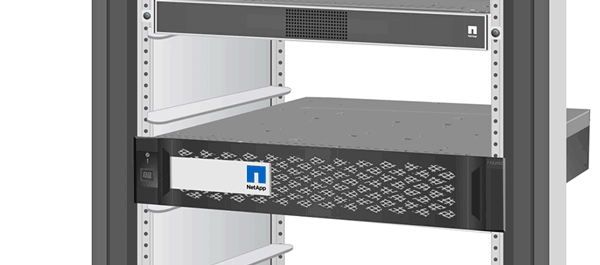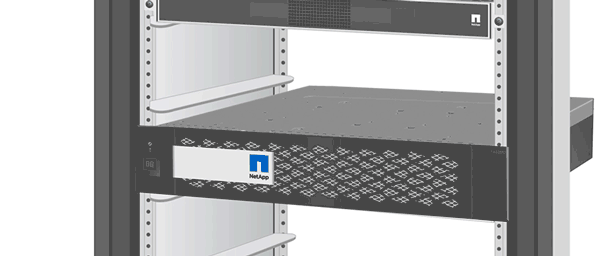Replace SSD Drive or HDD Drive - AFF A150
 Suggest changes
Suggest changes


You can replace a failed drive nondisruptively while I/O is in progress. The procedure for replacing an SSD is meant for non-spinning drives and the procedure for replacing an HDD is meant for spinning drives.
When a drive fails, the platform logs a warning message to the system console indicating which drive has failed. In addition, both the fault LED on the operator display panel and the fault LED on the failed drive are illuminated.
-
Follow best practice and install the current version of the Disk Qualification Package (DQP) before replacing a drive.
-
Identify the failed drive by running the
storage disk show -brokencommand from the system console.The failed drive appears in the list of failed drives. If it does not, you should wait, and then run the command again.
Depending on the type and capacity, it can take up to several hours for the drive to appear in the list of failed drives. -
Determine whether SED authentication is enabled.
How you replace the drive depends on how the drive is being used. If SED authentication is enabled, you must use the SED replacement instructions in the ONTAP 9 NetApp Encryption Power Guide. These Instructions describe additional steps you must perform before and after replacing an SED.
-
Make sure the replacement drive is supported by your platform. See the NetApp Hardware Universe.
-
Make sure all other components in the system are functioning properly; if not, you must contact technical support.
-
Drive firmware is automatically updated (nondisruptively) on new drives that have non current firmware versions.
-
When replacing a drive, you must wait one minute between the removal of the failed drive and the insertion of the replacement drive to allow the storage system to recognize the existence of the new drive.
-
If you want to manually assign drive ownership for the replacement drive, you need to disable automatic drive assignment, if it is enabled.
-
Verify whether automatic drive assignment is enabled:
storage disk option showYou can enter the command on either controller module.
If automatic drive assignment is enabled, the output shows
onin the “Auto Assign” column (for each controller module). -
If automatic drive assignment is enabled, disable it:
storage disk option modify -node node_name -autoassign offYou must disable automatic drive assignment on both controller modules.
-
-
Properly ground yourself.
-
Physically identify the failed drive.
When a drive fails, the system logs a warning message to the system console indicating which drive failed. Additionally, the attention (amber) LED on the drive shelf operator display panel and the failed drive illuminate.
The activity (green) LED on a failed drive can be illuminated (solid), which indicates that the drive has power, but should not be blinking, which indicates I/O activity. A failed drive has no I/O activity. -
Remove the failed drive:
-
Press the release button on the drive face to open the cam handle.
-
Slide the drive out of the shelf using the cam handle and supporting the drive with your other hand.
-
-
Wait a minimum of 70 seconds before inserting the replacement drive.
This allows the system to recognize that a drive was removed.
-
Insert the replacement drive:
-
With the cam handle in the open position, use both hands to insert the replacement drive.
-
Push until the drive stops.
-
Close the cam handle so that the drive is fully seated into the midplane and the handle clicks into place.
Be sure to close the cam handle slowly so that it aligns correctly with the face of the drive.
-
-
Verify that the drive's activity (green) LED is illuminated.
When the drive's activity LED is solid, it means that the drive has power. When the drive's activity LED is blinking, it means that the drive has power and I/O is in progress. If the drive firmware is automatically updating, the LED blinks.
-
If you are replacing another drive, repeat the preceding steps.
-
If you disabled automatic drive assignment in Step 1, then, manually assign drive ownership and then reenable automatic drive assignment if needed.
-
Display all unowned drives:
storage disk show -container-type unassignedYou can enter the command on either controller module.
-
Assign each drive:
storage disk assign -disk disk_name -owner node_nameYou can enter the command on either controller module.
You can use the wildcard character to assign more than one drive at once.
-
Reenable automatic drive assignment if needed:
storage disk option modify -node node_name -autoassign onYou must reenable automatic drive assignment on both controller modules.
-
-
Return the failed part to NetApp, as described in the RMA instructions shipped with the kit.
Contact NetApp Support if you need the RMA number or additional help with the replacement procedure.
-
If you want to manually assign drive ownership for the replacement drive, you need to disable automatic drive assignment replacement drive, if it is enabled
You manually assign drive ownership and then reenable automatic drive assignment later in this procedure. -
Verify whether automatic drive assignment is enabled:
storage disk option showYou can enter the command on either controller module.
If automatic drive assignment is enabled, the output shows
onin the “Auto Assign” column (for each controller module). -
If automatic drive assignment is enabled, disable it:
storage disk option modify -node node_name -autoassign offYou must disable automatic drive assignment on both controller modules.
-
-
Properly ground yourself.
-
Gently remove the bezel from the front of the platform.
-
Identify the failed disk drive from the system console warning message and the illuminated fault LED on the disk drive
-
Press the release button on the disk drive face.
Depending on the storage system, the disk drives have the release button located at the top or on the left of the disk drive face.
For example, the following illustration shows a disk drive with the release button located on the top of the disk drive face:

The cam handle on the disk drive springs open partially and the disk drive releases from the midplane.
-
Pull the cam handle to its fully open position to unseat the disk drive from the midplane.

-
Slide out the disk drive slightly and allow the disk to safely spin down, which can take less than one minute, and then, using both hands, remove the disk drive from the disk shelf.
-
With the cam handle in the open position, insert the replacement disk drive into the drive bay, firmly pushing until the disk drive stops.
Wait a minimum of 10 seconds before inserting a new disk drive. This allows the system to recognize that a disk drive was removed. If your platform drive bays are not fully loaded with drives, it is important to place the replacement drive into the same drive bay from which you removed the failed drive. Use two hands when inserting the disk drive, but do not place hands on the disk drive boards that are exposed on the underside of the disk carrier. -
Close the cam handle so that the disk drive is fully seated into the midplane and the handle clicks into place.
Be sure to close the cam handle slowly so that it aligns correctly with the face of the disk drive..
-
If you are replacing another disk drive, repeat Steps 4 through 9.
-
Reinstall the bezel.
-
If you disabled automatice drive assignment in Step 1, then, manually assign drive ownership and then reenable automatic drive assignment if needed.
-
Display all unowned drives:
storage disk show -container-type unassignedYou can enter the command on either controller module.
-
Assign each drive:
storage disk assign -disk disk_name -owner owner_nameYou can enter the command on either controller module.
You can use the wildcard character to assign more than one drive at once.
-
Reenable automatic drive assignment if needed:
storage disk option modify -node node_name -autoassign onYou must reenable automatic drive assignment on both controller modules.
-
-
Return the failed part to NetApp, as described in the RMA instructions shipped with the kit.
Contact technical support at NetApp Support, 888-463-8277 (North America), 00-800-44-638277 (Europe), or +800-800-80-800 (Asia/Pacific) if you need the RMA number or additional help with the replacement procedure.



